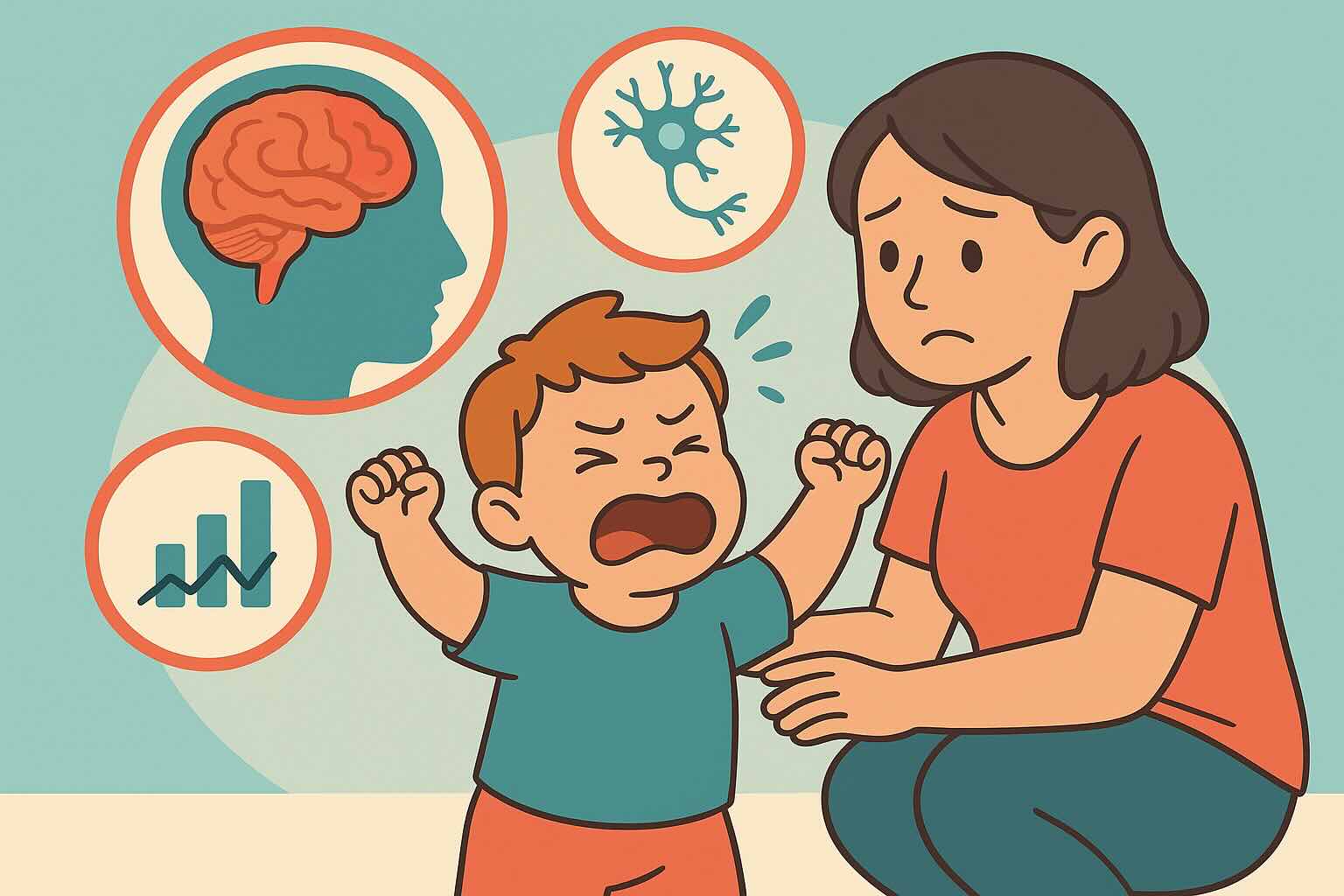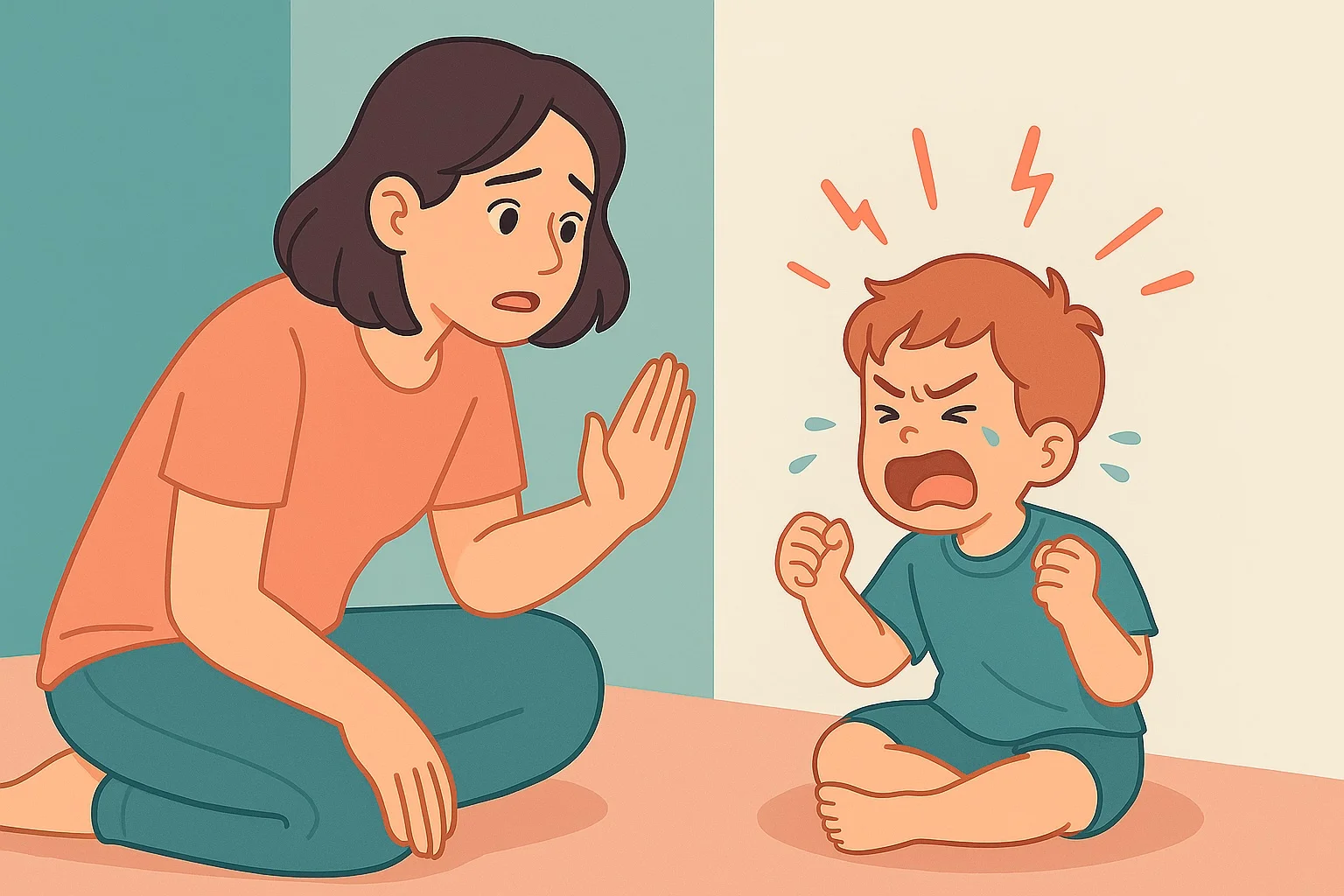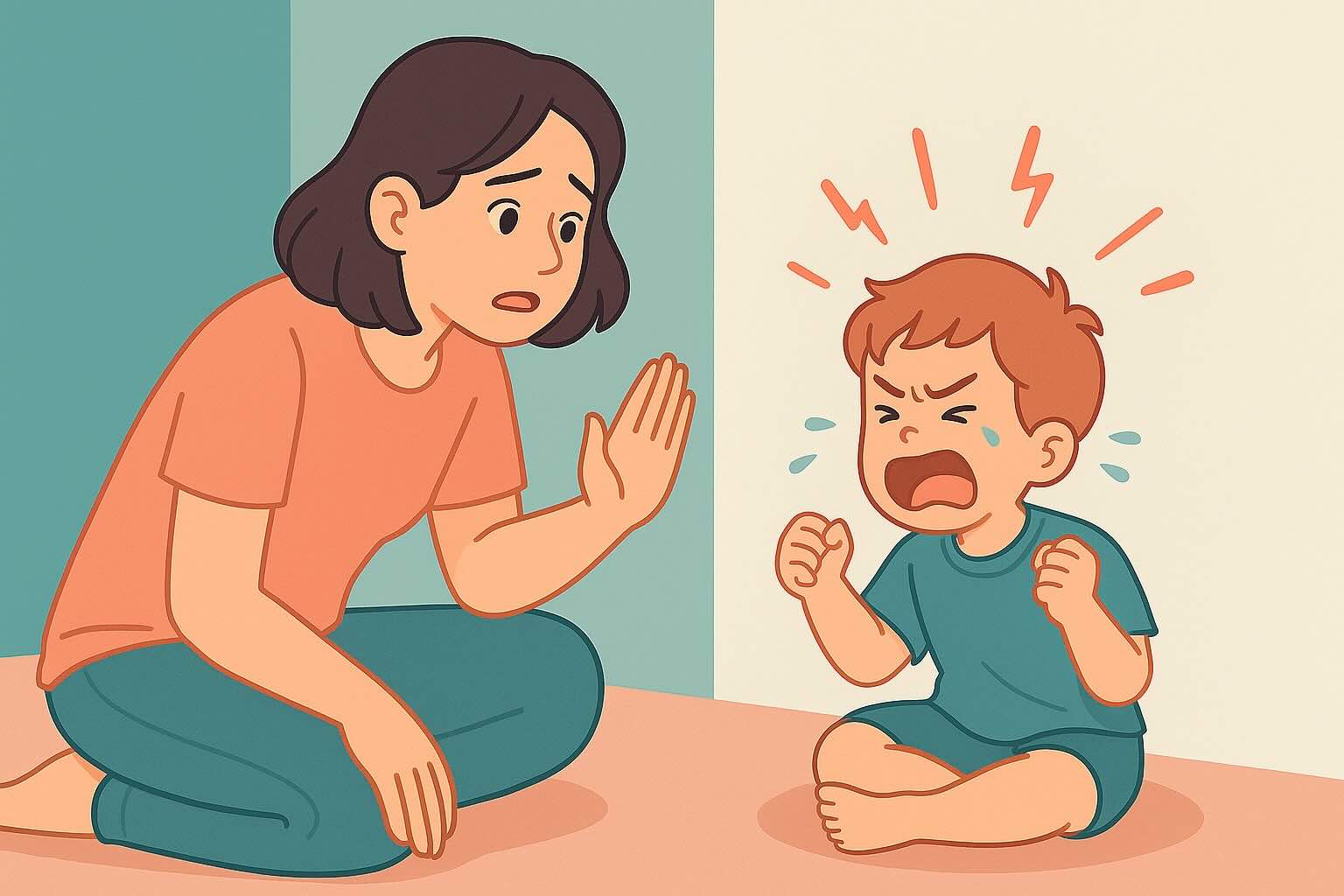The Science Behind Toddler Tantrums: What Every Parent Needs to Know


Understanding Tantrum Science: Watch This First
If you're reading this while hiding in the bathroom after your toddler's third meltdown today, take a deep breath. You're not alone, and more importantly, you're not failing as a parent. While tantrum frequency varies enormously between children, intense emotional outbursts are a normal part of development for most children between 18 months and 4 years.
This comprehensive guide provides evidence-based strategies that help most families see meaningful improvement within 4-6 weeks of consistent implementation. No more guessing, no more guilt—just practical tools grounded in developmental science.
For practical implementation, see our complete tantrum response guide with the 5-step method, and our prevention strategies to reduce meltdowns before they start. For specific communication techniques during meltdowns, our tantrum communication scripts guide provides age-appropriate phrases that help calm emotional storms.
What You'll Learn in This Guide
- The Real Science - Why your toddler's brain is still developing emotional regulation
- Modern Brain Understanding - Updated neuroscience beyond outdated "emotional vs. rational" models
- The 5-Step Response Method - Exactly what to say and do during meltdowns (detailed in our main tantrum guide)
- Prevention Strategies - How to reduce tantrums through environmental changes
- Age-Specific Approaches - Different techniques for 18-month vs 2-year-olds
- When to Seek Help - Red flags that indicate professional support is needed
- Real Parent Success Stories - How other families transformed their daily challenges
Estimated reading time: 10 minutes
The Toddler Brain: Why Tantrums Are Neurologically Normal
How Your Toddler's Developing Brain Handles Emotions
Your toddler's emotional responses can feel overwhelming because their brain is still developing the complex networks needed for emotional regulation. Unlike older models that suggested simple "emotional brain vs. rational brain" divisions, modern neuroscience shows that emotional regulation involves integrated networks across the entire brain.
Key developmental realities:
- Executive function skills (including emotional regulation) develop gradually through childhood
- Stress response systems are more reactive and recover more slowly in young children
- Language and emotional processing connections are still forming
- Impulse control networks won't be fully mature until the mid-twenties
This means your child isn't being "bad" or "manipulative"—they're working with a brain that's still learning how to manage big feelings.
The Science: Why Toddler Tantrums Peak at 18 Months to 4 Years
During this period, several developmental factors create the perfect storm for emotional outbursts:
- Cognitive development: They understand more than they can communicate or manage
- Independence drive: Growing autonomy desires clash with limited capabilities
- Language limitations: Big feelings with limited vocabulary for expression
- Physical needs sensitivity: Hunger, tiredness, and overstimulation have bigger impacts
- Emotional intensity: Feelings are experienced more intensely and recovered from more slowly
Normal vs. Concerning Tantrum Behaviors
Normal tantrum behaviors:
- Crying, screaming, throwing themselves down
- Hitting, kicking, or throwing objects (not targeting people)
- Duration typically 0.5-5 minutes (research shows 75% last 5 minutes or less)
- Ending when comforted, needs met, or child exhausts themselves
Research-based tantrum realities:
- Frequency: About 20% of 2-year-olds have daily tantrums; 50% have them 2-3 times weekly
- Peak intensity: 18-24 months, with significant improvement by age 4
- Individual variation: Some children naturally have more intense emotional responses due to temperament
Concerning behaviors that warrant professional consultation:
- Tantrums lasting longer than 15 minutes regularly
- More than 5 tantrums per day consistently
- Self-harm during tantrums (head banging, hitting themselves)
- Aggression toward others that doesn't improve with intervention
- Tantrums that worsen or increase in frequency after age 4
- Complete inability to be consoled for extended periods
- Property destruction during tantrums
- Persistent tantrums beyond age 5
The Science of Emotional Regulation: Dr. Dan Siegel's Research
"Name It to Tame It": The Neuroscience Behind Emotion Labeling
Dr. Dan Siegel, Clinical Professor of Psychiatry at UCLA and founder of the Mindsight Institute, has conducted extensive research on how naming emotions affects brain function. Neuroimaging studies show that when we put feelings into words (affect labeling), it activates the prefrontal cortex while reducing activity in the amygdala and other emotion-generating regions.
How this works in practice:
- Labeling emotions helps integrate different brain networks
- The process literally helps calm the nervous system
- Children learn to identify and eventually self-regulate emotions
- The effect works better as language skills develop
Important implementation notes:
- Works better with children who have developed language skills (2+ years)
- Requires repetition over time to build neural pathways
- Most effective when combined with validation and comfort
- Should be done with empathy, not as a technique to "fix" emotions
Modern Understanding: Beyond the "Triune Brain"
Important scientific update: While Dr. Siegel's emotion labeling research is solid, some popular explanations of brain function (like "flipping your lid" hand models) are based on outdated neuroscience. The "triune brain" theory suggesting separate emotional and rational brain regions has been thoroughly debunked since the 1970s.
Current neuroscience shows:
- The brain works as integrated networks, not separate regions
- Emotional and cognitive processes are interconnected throughout the brain
- There's no clear division between "emotional brain" and "rational brain"
- Stress affects multiple brain systems simultaneously
Why this matters for parents: Understanding that emotions and thinking are integrated helps us respond more appropriately to children's emotional needs rather than trying to shut down emotions in favor of logic.
The 5-Step Tantrum Response Method: Your Action Plan
This evidence-based framework provides structure during emotional storms. Each step builds on research about how children's brains process stress and learn emotional regulation.
Step 1: Stay Calm and Connect
Your first priority is your own emotional regulation. Research shows that children's stress systems are highly sensitive to caregiver emotional states. Taking a deep breath and getting on their eye level signals safety rather than threat.
What to say:
- "I'm right here with you."
- "You're safe."
- "I can see you're having big feelings."
What NOT to say:
- "Stop crying right now!"
- "You're being dramatic."
- "Big boys/girls don't cry."
Step 2: Name It to Tame It
Use Dr. Siegel's affect labeling approach to help activate integrative brain networks:
How to implement:
- "I see you're really angry that we have to leave the park."
- "You're frustrated because your tower fell down."
- "It's hard when you can't have the toy right now."
- "Your body is telling you that you're disappointed."
Step 3: Validate Without Giving In
Validation acknowledges emotions while maintaining necessary boundaries:
Validation scripts:
- "It makes sense that you're upset about this."
- "I would be disappointed too if I had to stop playing."
- "Your feelings are important to me."
Maintain the boundary:
- "AND we still need to leave the park."
- "AND we still can't have candy before dinner."
- "AND we still need to clean up our toys."
Step 4: Wait for Regulation
Don't try to reason during peak emotional intensity. Your job is to be a calm, safe presence while their nervous system processes the stress.
During this phase:
- Stay nearby without overwhelming them
- Keep your voice low and calm
- Offer comfort when they're ready to receive it
- Ensure physical safety without unnecessary restraint
Step 5: Problem-Solve Together
Once emotional intensity decreases (visible in body language and breathing), engage their developing reasoning skills:
Problem-solving questions:
- "What could we do differently next time?"
- "How can I help you when you feel this way?"
- "Would you like to try again?"
Prevention Strategies Based on Developmental Science
Meeting Basic Needs: The HALT Framework
Research consistently shows that addressing basic needs reduces behavioral problems in young children:
- Hungry: Keep healthy snacks available and maintain regular meal timing
- Angry: Address underlying frustrations before they escalate
- Lonely: Ensure adequate positive attention and connection
- Tired: Maintain consistent sleep schedules and recognize fatigue signs
Note: While HALT is clinically useful, specific research validating this framework for toddler tantrum prevention is limited.
Environmental Setup for Success
Create predictable routines:
- Consistent daily schedules reduce stress on developing nervous systems
- Transition warnings (5-10 minutes) help children mentally prepare
- Visual schedules support children who are developing language skills
- Predictability reduces anxiety and emotional reactivity
Reduce overstimulation:
- Limit sensory input before challenging activities
- Create quiet spaces for emotional regulation
- Use calming environmental cues (soft lighting, quiet music)
- Offer manageable choices (2-3 options) rather than overwhelming freedom
Proactive Emotional Education
During calm moments:
- Read books about emotions and feelings
- Practice simple breathing exercises ("smell the flower, blow out the candle")
- Use emotion identification games with feeling faces or cards
- Model your own emotional regulation out loud
Build regulation skills:
- Practice counting or other self-soothing techniques
- Create a designated calm-down space with comfort items
- Teach simple physical regulation techniques (deep breathing, gentle movement)
- Use play and stories to practice emotional scenarios
Age-Specific Strategies Based on Development
18-24 Months: Communication and Basic Needs Focus
At this age, tantrums primarily stem from communication frustration and basic needs:
Effective strategies:
- Use simple, concrete language (2-4 words)
- Provide physical comfort and consistent presence
- Redirect to sensory activities (water, music, movement)
- Maintain very predictable routines
- Support communication with gestures, pictures, or simple signs
Common triggers:
- Inability to communicate needs or wants
- Overstimulation from environment
- Hunger, tiredness, or physical discomfort
- Wanting something visible but not accessible
2-3 Years: Independence and Control
Peak tantrum period as children assert autonomy without necessary skills:
Effective strategies:
- Offer limited, appropriate choices
- Use "when/then" language ("When you put on shoes, then we can go outside")
- Create "yes" spaces where they can have real control
- Use visual timers for transitions
- Acknowledge their growing independence while maintaining safety
Common triggers:
- Desire for control over environment and decisions
- Difficulty with transitions between activities
- Feeling rushed by adult schedules
- Testing boundaries and exploring consequences
3-4 Years: Reasoning and Social Development
Children can understand more complex explanations but still struggle with emotional regulation:
Effective strategies:
- Explain simple cause-and-effect relationships
- Practice emotion coaching during calm moments
- Create collaborative problem-solving opportunities
- Set clear expectations with logical consequences
- Build on their developing empathy and social awareness
Common triggers:
- Frustration with tasks beyond current abilities
- Social challenges and peer conflicts
- Feeling misunderstood or not heard
- Testing social rules and adult responses
Realistic Expectations About Success
What Research Actually Shows About Intervention Effectiveness
Realistic improvement timelines:
- Most families see some improvement within 2-4 weeks of consistent approach
- Meaningful reduction in frequency or intensity occurs for 60-70% of families
- Complete elimination of tantrums is unrealistic and developmentally inappropriate
- High-intensity children may need 6-8 weeks to show significant improvement
Success typically means:
- Shorter tantrum duration (from 10 minutes to 3 minutes, for example)
- Faster recovery and return to baseline mood
- Reduced frequency of major meltdowns
- Improved ability to accept comfort and co-regulation
Important factors affecting success:
- Consistency across all caregivers is crucial
- Child's individual temperament significantly affects timeline
- Family stress and environmental factors impact effectiveness
- Developmental regressions can temporarily increase tantrums
When to Seek Professional Help
Red Flags That Warrant Professional Consultation
- Tantrums lasting longer than 15 minutes regularly
- More than 5 tantrums per day consistently for children over 24 months
- Self-harm during tantrums (head banging, breath holding, hitting self)
- Aggression toward others that doesn't improve with intervention
- Tantrums that worsen or increase in frequency after age 4
- Inability to be consoled without extensive intervention
- Developmental regression (loss of previously acquired skills)
- Property destruction during emotional episodes
- Family functioning significantly impacted for more than 2 months
Types of Professional Support Available
Child psychologists specialize in behavioral strategies and emotional regulation development Occupational therapists help with sensory processing issues that may contribute to emotional dysregulation Pediatricians can rule out medical causes and provide developmental perspective Early intervention specialists work specifically with children under 3 and their families Family therapists assist with family dynamics and parenting stress management
How to Find Qualified Help
- Start with your pediatrician for appropriate referrals
- Contact your insurance company for covered providers
- Look for specialists with experience in toddler behavior and development
- Ask about their approach to ensure alignment with your family values
- Consider university training clinics for evidence-based interventions
Real-Life Success Stories
Sarah's Story: Understanding Individual Temperament
"Emma has always been a highly sensitive child who gets overwhelmed easily. Traditional tantrum advice didn't work because it didn't account for her temperament. Once we started recognizing her early warning signs and created more sensory breaks throughout the day, her tantrums became much more manageable. It took about 8 weeks to see consistent improvement, but understanding her individual needs made all the difference."
Mike's Story: The Power of Routine and Preparation
"My 2-year-old Jake would have major meltdowns during transitions, especially leaving fun activities. We started using visual timers, giving multiple warnings, and creating 'transition rituals' like saying goodbye to the playground equipment. It took about a month of consistency, but now he handles transitions much better. We still prep him extra for big changes, and it really helps."
Lisa's Story: Addressing Underlying Needs
"I thought my daughter was just being difficult during bedtime, but I realized she was actually overstimulated and overtired by that point in the day. We moved bedtime earlier, created a longer wind-down routine, and reduced stimulation in the evening. The tantrums didn't disappear overnight, but after about 6 weeks, bedtime became much more peaceful. Understanding the 'why' behind the behavior was key."
Your Evidence-Based 6-Week Action Plan
Weeks 1-2: Observation and Understanding
- Track tantrum patterns (time, triggers, duration, what helps)
- Notice your child's individual warning signs and escalation patterns
- Practice staying calm during meltdowns without trying to immediately fix
- Begin using simple emotion labeling ("You seem really frustrated")
Weeks 3-4: Prevention and Environmental Changes
- Implement HALT check before potentially challenging situations
- Create more predictable routines with transition warnings
- Reduce known overstimulation triggers in your environment
- Start offering appropriate choices throughout the day
Weeks 5-6: Integrated Response and Skills Building
- Use the complete 5-step response method consistently
- Focus on validation while maintaining necessary boundaries
- Wait for emotional regulation before attempting problem-solving
- Teach emotional regulation skills during calm, connected moments
Ongoing: Maintenance and Adaptation
- Continue tracking progress and adjusting strategies as needed
- Remember that development isn't linear—expect occasional setbacks
- Build on your child's growing emotional vocabulary and regulation skills
- Plan ahead for challenging situations and major transitions
The Neuroscience of Long-Term Development
Building Emotional Intelligence for Life
Every time you respond with patience and understanding, you're helping build your child's emotional regulation neural networks. Research shows that children who develop these skills early have:
- Better peer relationships throughout childhood and adolescence
- Improved academic performance due to enhanced self-control and focus
- Lower rates of anxiety and depression in later childhood and adolescence
- Stronger problem-solving skills and resilience in facing challenges
- Enhanced empathy and social competence in relationships
The Role of Co-Regulation in Brain Development
Co-regulation (your calm presence helping your child regulate) is essential for developing self-regulation. When you stay calm during your child's emotional storms, you're:
- Modeling emotional regulation in real-time
- Providing a secure base from which they can learn
- Teaching them that emotions are manageable and temporary
- Building trust that you'll be there during difficult moments
Individual Differences in Emotional Development
Temperament factors affecting tantrum patterns:
- Sensitivity level: Some children are more reactive to environmental stimuli
- Intensity: Natural emotional intensity varies significantly between children
- Adaptability: Some children need more time and support with transitions
- Persistence: Strong-willed children may have more intense reactions to limits
Understanding your child's temperament helps you:
- Adjust expectations realistically
- Provide appropriate environmental supports
- Choose strategies that match their individual needs
- Recognize that their challenges don't reflect your parenting quality
Cultural and Individual Considerations
Recognizing Diverse Expressions of Emotion
Cultural factors that influence emotional expression:
- Different cultures have varying expectations for emotional expression
- Family communication styles affect how children learn to express feelings
- Socioeconomic stress can impact both child behavior and parenting resources
- Extended family involvement may provide additional support or create challenges
Neurodivergent considerations:
- Autistic children may have different sensory needs and communication styles
- ADHD can affect impulse control and emotional regulation development
- Anxiety disorders may manifest as increased tantrum frequency or intensity
- Developmental delays may require modified approaches and extended timelines
Adapting Strategies for Your Family
Consider your family's unique factors:
- Work schedules and childcare arrangements
- Sibling dynamics and family size
- Living situation and available space
- Support system availability
- Parental stress levels and mental health
Key Takeaways: Your Science-Based Tantrum Guide
- ✅ Modern neuroscience shows integrated brain networks rather than separate emotional/rational regions
- ✅ Dr. Siegel's emotion labeling research is solid and helps develop emotional regulation skills
- ✅ Tantrums are developmentally normal with significant individual variation in frequency and intensity
- ✅ Your child's emotional responses reflect brain development, not character flaws or poor parenting
- ✅ Prevention through routine and needs-meeting is more effective than reaction alone
- ✅ The 5-step method provides structure but requires consistent implementation over time
- ✅ Realistic improvement takes 4-6 weeks with individual variation based on temperament
- ✅ Professional help is available when tantrums become concerning or unmanageable
- ✅ You're building lifelong emotional intelligence through your patient, consistent responses
Conclusion: Science-Informed Parenting
Understanding the science behind toddler tantrums doesn't make them less challenging, but it can transform how you respond. When you know that your child's brain is still developing the complex networks needed for emotional regulation, their intense reactions become less personal and more manageable.
The research is clear: Children who learn emotional regulation skills with patient, consistent support develop better emotional intelligence, stronger relationships, and greater resilience throughout life. Your calm, understanding responses during their most difficult moments are literally helping wire their brains for future emotional success.
Remember: You're not just surviving tantrums—you're teaching your child how to understand and manage emotions for life. This is some of the most important work you'll ever do as a parent.
For specific challenging situations, explore our guides on public tantrum management and identifying hidden tantrum triggers that many parents miss. If bedtime tantrums are particularly challenging, our night tantrums guide addresses the unique factors that make evening meltdowns more intense.
This article is based on current research in developmental neuroscience, child psychology, and attachment theory. Individual experiences vary significantly based on child temperament, family circumstances, and implementation consistency. Always consult with your pediatrician if you have concerns about your child's emotional development or behavior patterns.
24/7 AI Parenting Assistant
Get instant, personalized advice with expert-curated parenting knowledge. Chat with your AI coach anytime, anywhere.

Struggling with tantrums?
Get personalized coaching support available 24/7. Your parenting coach understands what you're going through.
Try RootWise Free →Free Tantrum Scripts
Help your toddler manage big emotions with these strategies and scripts.
Frequently Asked Questions
Need personalized support?
RootWise's AI coach can provide tailored strategies for your specific situation, available 24/7 when you need it most.
Learn More About AI Coaching →



